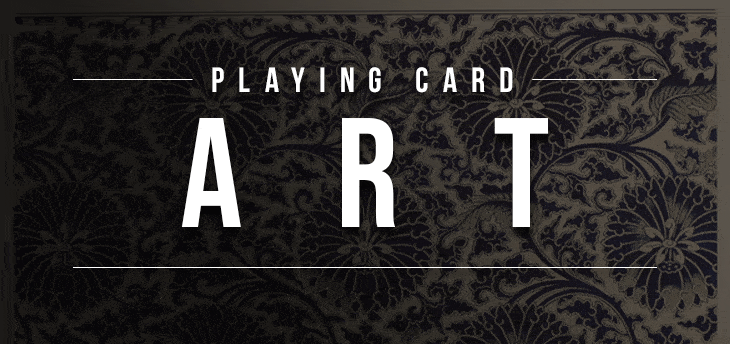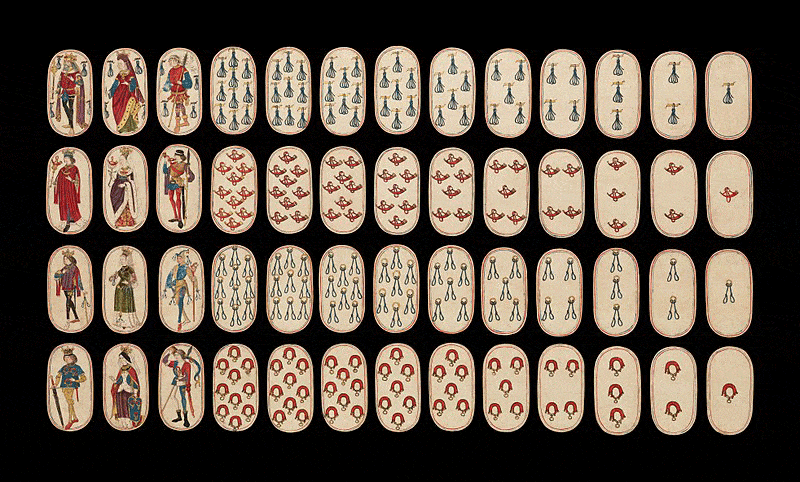Playing Card Art and History

In the realm of everyday objects often taken for granted, playing cards stand out as a remarkable fusion of art, history, and culture. This journey into the world of playing card art is not merely about appreciating the aesthetic beauty of these miniature canvases; it’s an exploration into the heart of human creativity and cultural exchange. From their enigmatic origins in ancient China to the vibrant, diverse decks of today, playing cards are more than just tools for games. They are silent witnesses to history, shaped by the hands of artists, kings, and commoners alike. As we delve into this history, we uncover the fascinating evolution of playing cards – an evolution that mirrors our own societal shifts, technological advances, and artistic aspirations. Join us as we shuffle through the centuries, exploring how a simple game piece became a captivating showcase of human ingenuity.

German Innovation and English Refinement
Germany played a crucial role in mass-producing cards, thanks to their wood-cutting and engraving techniques. They even influenced the design of suits, introducing rural life symbols like hearts, leaves, acorns, and bells. Across the channel, England left its mark by renaming the suits and making the Ace of Spades a card of prominence due to tax laws.
The American Dream: From Advertising to Collectibles
In the United States, playing cards took on a new life. The 19th century saw them become mediums of advertising and icons of the Wild West. Moreover, the U.S. became a haven for collectors, with cards ranging from sports legends to popular fandoms.
The Artistic Evolution: From Classical to Contemporary
Throughout history, playing cards have been a canvas for artistic expression. From hand-painted decks with ornate patterns to modern cards pushing creative boundaries, they reflect the ever-changing human imagination. This evolution has been continuous, with new designs emerging, reflecting both tradition and originality.
The Joker
The Joker, an integral part of modern playing card decks, originated in the 1860s in America, evolving from the trump card in the game of Euchre. This card, initially known as the Best Bower, later became known as the Joker, a name believed to be derived from the German term “Juker” used in Euchre. Its role expanded significantly over time, especially in games like Canasta and Poker, where it typically serves as a wild card. By the late 1940s, it became common for decks to include two Jokers, further cementing its place in card games across the globe.
The artistic representation of the Joker is as varied as its roles in different card games. Each card manufacturer brings their unique style to the Joker, often reflecting contemporary cultural themes or whimsical jesters and clowns. This variety has made the Joker a popular subject for collectors, with unique and rare designs being sought after worldwide. The Joker’s adaptability and diverse appearances highlight its enduring appeal in the world of playing cards.

The Art of the Reverse: A Peek at the Backs of Playing Cards
While the front of playing cards often steals the show with intricate designs and royal characters, the back of the cards holds its own tale of artistic evolution and cultural significance. The journey of cardbacks, often seen as mere canvases for patterns and colors, is as fascinating as the faces they conceal.
The Artistic Revolution of Card Backs
The transformation of playing cardbacks into an artistic showcase began in earnest in the 19th century. One of the most notable designers of this era was Owen Jones, who created a range of intricate back designs for De La Rue from 1851 to 1875. These designs were aesthetically pleasing and set a new standard in playing card artistry. Other manufacturers like Goodall and Reynolds followed suit, each bringing their unique style to the table. Goodall, in particular, was known for its elaborate designs from the 1860s onwards.
Reynolds & Sons also claimed their place in this history. They asserted that it was Joseph Reynolds who first introduced decorative backs in 1831 for the coronation of William IV, predating De La Rue’s contributions. This claim indicates the competitive and innovative spirit of the time, as manufacturers vied to create the most appealing and distinctive designs.
Beyond Aesthetics
The back designs of playing cards weren’t merely about aesthetics; they played a crucial functional role. Consistency and lack of identifiable marks on the backs were essential to ensure fair play. Any deviation or unique marking could give away the identity of the card, which is why uniformity was key.
The Legacy and Influence
The legacy of these early designs continue to influence modern playing cardbacks. While the styles have evolved, the principle of combining art with functionality remains central. Today, playing cardbacks are a blend of traditional patterns, innovative designs, and even thematic representations reflecting various cultures and interests.
A Tapestry Woven Through Time
From front to back, playing card art is more than just aesthetics; it’s a rich tapestry that narrates the story of human culture and innovation. From their origins in ancient China to the modern decks in our hands today, they have danced through history, embodying the spirit of their times. They are a testament to our enduring fascination with art, culture, and the human experience. As we shuffle and deal, we’re not just playing a game; we’re holding centuries of human creativity in our hands.
Whether you’re a fan of high-stakes cash games or the excitement of multi-table poker tournaments, GGPoker is the premier destination for poker enthusiasts. For those aiming to compete for a prestigious WSOP bracelet, push through the ranks for a WSOP Circuit ring, or simply hone their strategies in classic games or poker formats, GGPoker has something for everyone. The platform offers a seamless online poker experience, with innovative features like Smart HUD, PokerCraft, and integrated staking, designed to elevate your game. Whether you’re grinding your way up in daily cash games or competing for life-changing prizes in major online series, GGPoker provides the best environment to play, improve your poker skills, and succeed in the world of online poker. And if you are not sure where to start, you can always play free poker games and learn at the GGPoker School.





